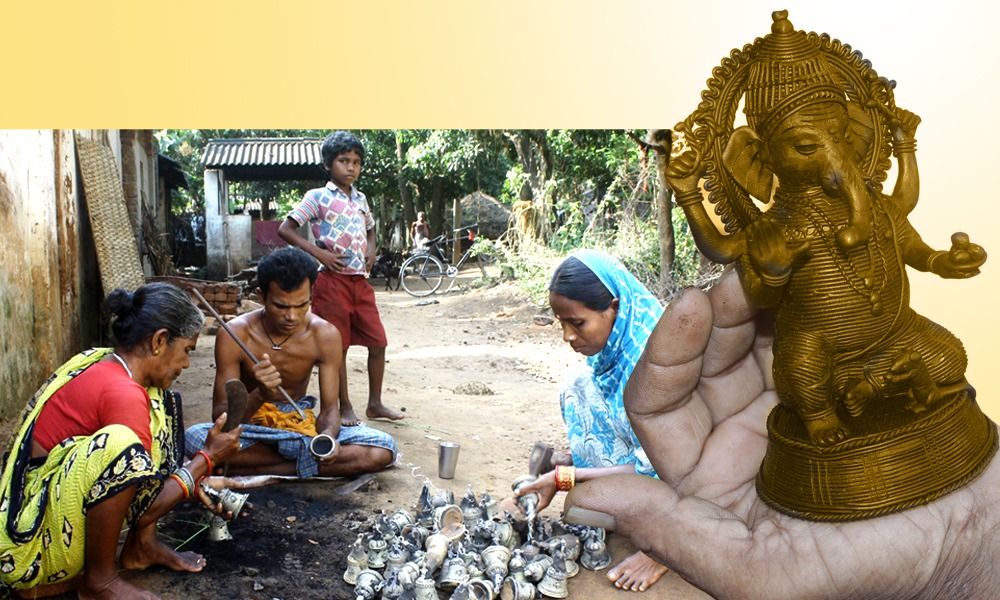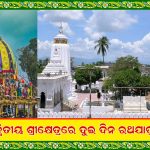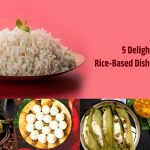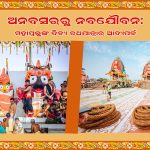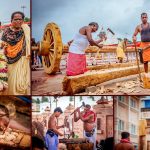India’s artistic heritage is a vibrant mosaic, each region adding its unique touch to the nation’s cultural tapestry.
Like the appliqué works of Pipili or Pattachitras and Papier Mache masks of Puri; silver filigree jewellery and golden grass mats of Cuttack or ‘Kataki’ and Ikkat saree of Cuttack and Sambalpur and Barapali or the Lacquer work of Nabarangapur or the flexible brass fish of Ganjam. Each handicraft exudes a charm and originality of its own and pristine beauty that remains untouched by time. Like that, there is another art form which is Dhokra of Mayurbhanj. This intricate art form not only showcases India’s rich artisanal traditions but also continues to enchant art enthusiasts around the world.
The Origins of Dhokra Art
Dhokra art, also known as Dokra, dates back over 4,000 years. The name “Dhokra” comes from the Dhokra Damar tribes, the traditional metal-smiths of West Bengal and Odisha. This technique has been meticulously passed down through generations, preserving its unique style and method. Dhokra art is celebrated for its rustic and primitive aesthetics, characterized by intricate patterns, stylized forms, and an earthy charm. Common motifs include tribal deities, animals, nature, and scenes from everyday life. Each piece is unique, reflecting the individuality and skill of the artisan.
The Lost-Wax Technique
Dhokra art, employs the lost-wax casting technique. This intricate process begins with creating a clay core model, which is then coated with beewax. After detailing the wax model, it is covered with layers of clay, forming a mold. When heated, the wax melts away, leaving a cavity into which molten metal is poured. Once cooled, the clay mold is broken to reveal the final metal piece, which is polished and finished by hand.
Dhokra Handicrafts
The products made by Dhokra artisans are in great demand in domestic and foreign markets as theyare distinguished by their appealing folk patterns, and clean and sharp lines. Now there are beautiful dhokra bracelets, necklaces, earrings, rakhis and anklets that the current artists create using a mix of old and new designs. These jewelry designs are inspired by local deities, the sun, the moon, the forest, flora and animals, and so forth.
Apart from jewelry, there are dhokra items used in everyday domestic chores, such as bowls and volume measurements for rice or grains. Demand for Dhokra home decor and kitchenware has also increased. A Few of these items include decorative picture or photo frames, wall panels, door knobs, lanterns, water jugs, flower vases, coasters, soap cases, ashtrays, bells, key holders, cutlery items, and other goods.
The rusty appearance of Dhokra jewelry adds charm and elegance to each item. It always stands out among other ornaments and is one-of-a-kind that can also make an excellent gift. You can shop for some beautiful and unique dhokra products on the website www.dhokrahandicrafts.com and buy exquisite handmade tribal jewelry.
Challenges and Preservation
Despite its beauty, Dhokra art faces certain challenges, including competition from mass-produced goods and a declining number of traditional artisans. Efforts by various organizations to promote and support these artisans are crucial for the craft’s survival. Dhokra art of Odisha is more than a beautiful artifact; it is a piece of living history. By appreciating and supporting this craft, we help preserve an integral part of India’s cultural heritage, ensuring its stories and traditions endure for future generations.
India’s artistic heritage is a vibrant mosaic, each region adding its unique touch to the nation’s cultural tapestry.
Like the appliqué works of Pipili or Pattachitras and Papier Mache masks of Puri; silver filigree jewellery and golden grass mats of Cuttack or ‘Kataki’ and Ikkat saree of Cuttack and Sambalpur and Barapali or the Lacquer work of Nabarangapur or the flexible brass fish of Ganjam. Each handicraft exudes a charm and originality of its own and pristine beauty that remains untouched by time. Like that, there is another art form which is Dhokra of Mayurbhanj. This intricate art form not only showcases India’s rich artisanal traditions but also continues to enchant art enthusiasts around the world.
The Origins of Dhokra Art
Dhokra art, also known as Dokra, dates back over 4,000 years. The name “Dhokra” comes from the Dhokra Damar tribes, the traditional metal-smiths of West Bengal and Odisha. This technique has been meticulously passed down through generations, preserving its unique style and method. Dhokra art is celebrated for its rustic and primitive aesthetics, characterized by intricate patterns, stylized forms, and an earthy charm. Common motifs include tribal deities, animals, nature, and scenes from everyday life. Each piece is unique, reflecting the individuality and skill of the artisan.
The Lost-Wax Technique
Dhokra art, employs the lost-wax casting technique. This intricate process begins with creating a clay core model, which is then coated with beewax. After detailing the wax model, it is covered with layers of clay, forming a mold. When heated, the wax melts away, leaving a cavity into which molten metal is poured. Once cooled, the clay mold is broken to reveal the final metal piece, which is polished and finished by hand.
Dhokra Handicrafts
The products made by Dhokra artisans are in great demand in domestic and foreign markets as theyare distinguished by their appealing folk patterns, and clean and sharp lines. Now there are beautiful dhokra bracelets, necklaces, earrings, rakhis and anklets that the current artists create using a mix of old and new designs. These jewelry designs are inspired by local deities, the sun, the moon, the forest, flora and animals, and so forth.
Apart from jewelry, there are dhokra items used in everyday domestic chores, such as bowls and volume measurements for rice or grains. Demand for Dhokra home decor and kitchenware has also increased. A Few of these items include decorative picture or photo frames, wall panels, door knobs, lanterns, water jugs, flower vases, coasters, soap cases, ashtrays, bells, key holders, cutlery items, and other goods.
The rusty appearance of Dhokra jewelry adds charm and elegance to each item. It always stands out among other ornaments and is one-of-a-kind that can also make an excellent gift. You can shop for some beautiful and unique dhokra products on the website www.dhokrahandicrafts.com and buy exquisite handmade tribal jewelry.
Challenges and Preservation
Despite its beauty, Dhokra art faces certain challenges, including competition from mass-produced goods and a declining number of traditional artisans. Efforts by various organizations to promote and support these artisans are crucial for the craft’s survival. Dhokra art of Odisha is more than a beautiful artifact; it is a piece of living history. By appreciating and supporting this craft, we help preserve an integral part of India’s cultural heritage, ensuring its stories and traditions endure for future generations.
